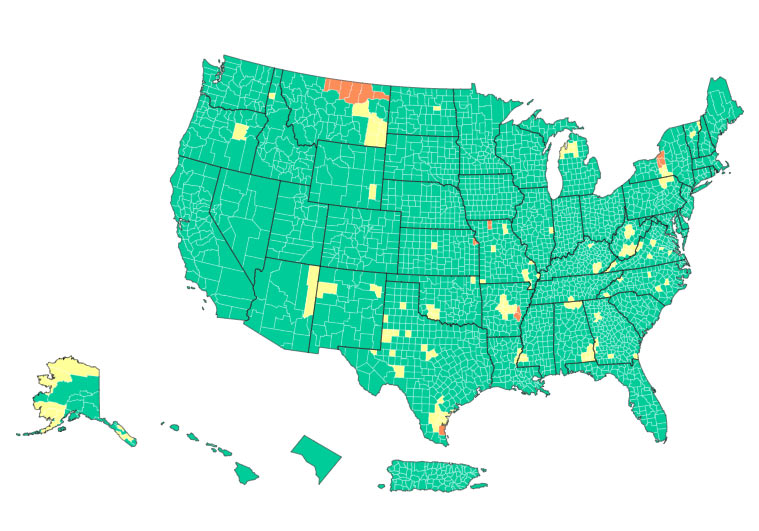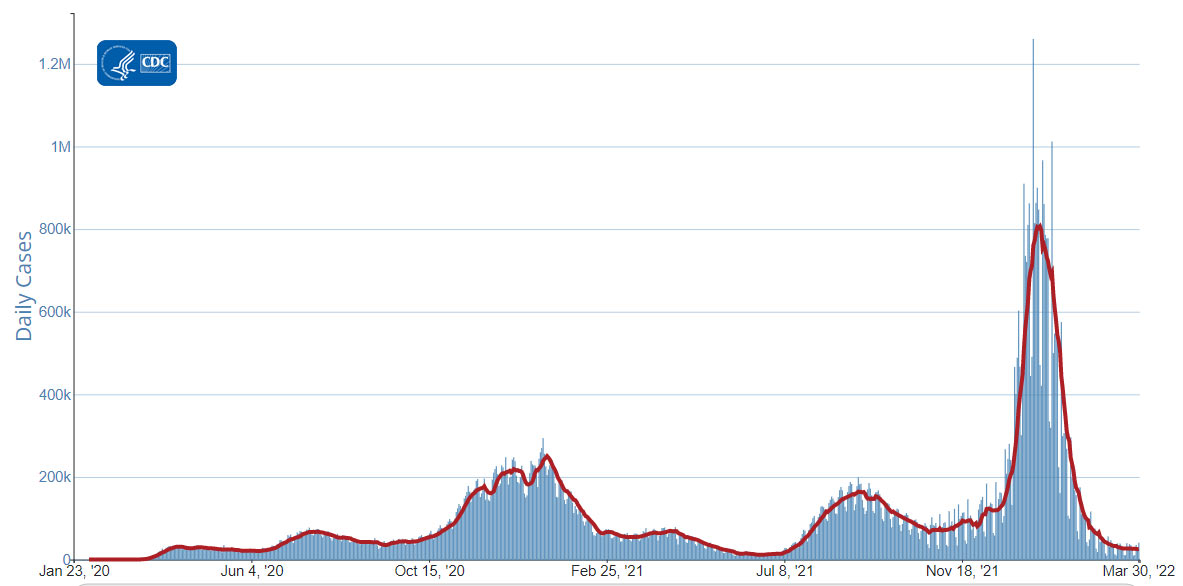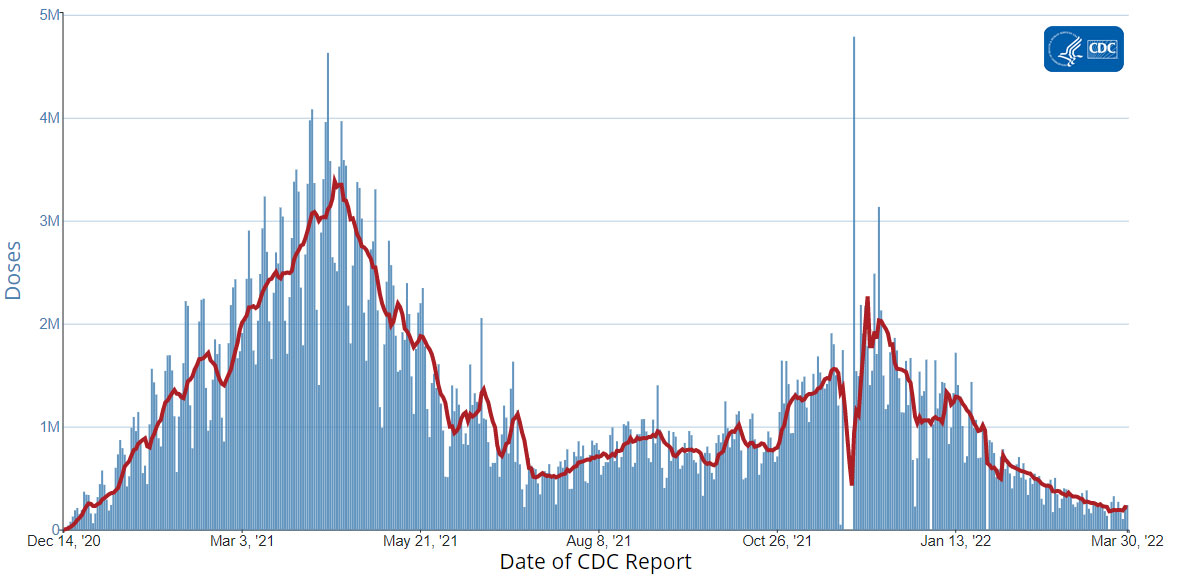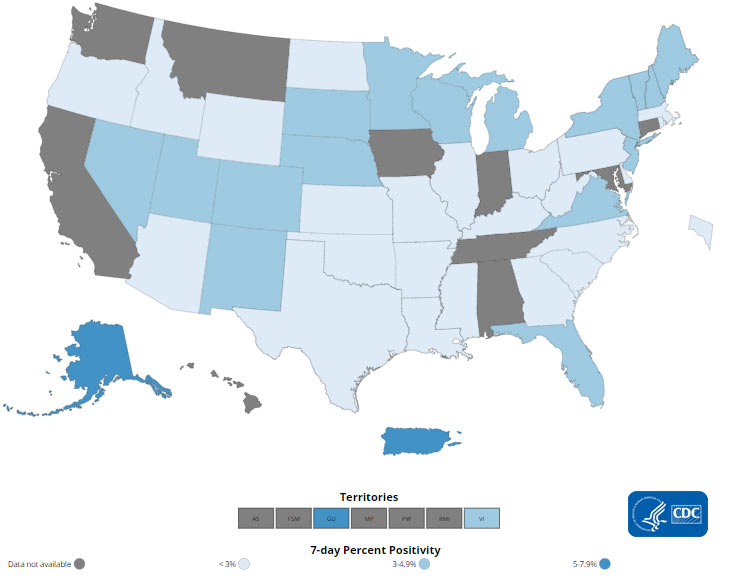Recommendations for Fully Vaccinated People
COVID-19 Homepage
Added Protection
Interpretive Summary for April 1, 2022
Added Protection
As the country emerges from the Omicron surge—and we experience low COVID-19 Community levels in most parts of the country—CDC has updated its COVID-19 vaccination guidance to give some people the option to get a second mRNA COVID-19 booster dose (Pfizer-BioNTech or Moderna). You can now receive a second booster dose if you:
- Received the Johnson & Johnson/Janssen vaccine as both your primary and booster dose at least four months ago*
- Are ages 50 years and older and received any booster dose at least four months ago
- Are moderately or severely immunocompromised, ages 12 years and older, and received any booster dose at least four months ago
COVID-19 vaccines continue to offer high levels of protection against severe disease, hospitalization, and death—especially for people who are boosted. During the recent Omicron surge, people who were boosted were 21 times less likely to die from COVID-19 compared to those who were unvaccinated, and 7 times less likely to be hospitalized. If you’re interested in getting a second booster, find a vaccine now.
*A recent CDC study found that adults who received the J&J/Janssen COVID-19 vaccine as both their primary dose and booster dose had lower levels of protection against COVID-19-associated hospitalizations, as well as emergency department and urgent care visits, during Omicron compared to adults who received an mRNA COVID-19 vaccine booster dose. As such, they may benefit from an mRNA COVID-19 vaccine booster dose and are now eligible to receive one.
- COVID Data Tracker added a new Dialysis Facilities tab that displays COVID-19 cases and deaths among patients and staff of dialysis facilities in the United States.
- COVID Data Tracker’s Hospitalizations by Vaccination Status – COVID-NET tab now displays rates of COVID-19-associated hospitalizations, stratified by unvaccinated, fully vaccinated, and boosted, among the population ages 12–17 years old.
- COVID Data Tracker’s Vaccination Trends tab now displays a new metric option called “Vaccination Coverage,” which shows the percent of the total population that has received at least one dose and has completed a primary series (fully vaccinated) as well as the percent of the total fully vaccinated population that has received a booster dose over time, by jurisdiction.
- Effectiveness of Homologous and Heterologous COVID-19 Booster Doses Following 1 Ad.26.COV2.S (Janssen [Johnson & Johnson]) Vaccine Dose Against COVID-19–Associated Emergency Department and Urgent Care Encounters and Hospitalizations Among Adults — VISION Network, 10 States, December 2021–March 2022
- Use of At-Home COVID-19 Tests — United States, August 23, 2021–March 12, 2022
- Cardiac Complications After SARS-CoV-2 Infection and mRNA COVID-19 Vaccination — PCORnet, United States, January 2021–January 2022
COVID-19 Community Levels
On February 25, 2022, CDC updated the way it monitors COVID-19’s impact on our communities. Widespread availability of vaccines and testing, advances in treatments, and increasing levels of immunity in the population through vaccination or previous infection have moved the COVID-19 pandemic to a new phase. While we can’t prevent all cases of COVID-19, we can continue to limit the spread and protect those who are most at risk of severe illness.
Currently, there are 19 (0.59%) counties with a high COVID-19 Community Level, 146 (4.53%) counties with a medium Community Level, and 3,059 (94.88%) counties with a low Community Level. This represents a slight (−0.84%) decrease in the number of high-level counties, a moderate (−2.73%) decrease in the number of medium-level counties, and a corresponding (+3.57%) increase in the number of low-level counties. Twenty-seven (48.21%) of 56 jurisdictions had no high- or medium-level counties this week.
To check your COVID-19 community level, visit COVID Data Tracker.
Reported Cases
As of March 30, 2022, the current 7-day moving average of daily new cases (25,732) decreased 3.0% compared with the previous 7-day moving average (26,518). A total of 79,904,464 COVID-19 cases have been reported in the United States as of March 30, 2022.
CDC Nowcast projections* for the week ending March 26, 2022, estimate the combined national proportion of lineages designated as Omicron to be 100%. There are five lineages designated as Omicron: B.1.1.529, BA.1, BA.1.1, BA.2, and BA.3. COVID Data Tracker shows the proportions of the B.1.1.529 lineage (includes BA.1 and BA.3), the BA.1.1** lineage, and the BA.2 lineage. The predominant Omicron lineage in the United States is BA.2. The national proportion of BA.2 is projected to be 54.9% (95% PI 50.8-59.1%). BA.1.1 is projected to be 40.4% (95% PI 36.4-44.5%) and B.1.1.529 (BA.1 and BA.3) is projected to be 4.7% (95% PI 3.9-5.7%). Omicron is predicted to be 100% in all HHS regions.
79,904,464
Total Cases Reported
79,904,464
Total Cases Reported
25,732
Current 7-Day Average**
25,732
Current 7-Day Average**
26,518
Prior 7-Day Average
26,518
Prior 7-Day Average
-3.0%
Change in 7-Day Average since Prior Week
-3.0%
Change in 7-Day Average since Prior Week
*The median time from specimen collection to sequence data reporting is about 3 weeks. As a result, weighted estimates for the most recent few weeks may be unstable or unavailable. CDC’s Nowcast is a data projection tool that helps fill this gap by generating timely estimates of variant proportions for variants that are circulating in the United States. View Nowcast estimates on CDC’s COVID Data Tracker website on the Variant Proportions page.
**For national data, the proportion of BA.1.1 is shown separately. For regional data, the proportion of BA.1.1 is also aggregated with B.1.1.529.
***Historical cases are excluded from daily new cases and 7-day average calculations until they are incorporated into the dataset for the applicable date. Of 504,648 historical cases reported retroactively, 18,610 were reported in the current week and 10,468 were reported in the prior week.
Vaccinations
The U.S. COVID-19 Vaccination Program began December 14, 2020. As of March 30, 2022, 560.4 million vaccine doses have been administered in the United States. Overall, about 255.4 million people, or 76.9% of the total U.S. population, have received at least one dose of vaccine. About 217.6 million people, or 65.5% of the total U.S. population, have been fully vaccinated.* About 97.5 million additional or booster doses have been reported in people who have been fully vaccinated; however, 49.8% of the total booster-eligible population has not yet received a booster dose. As of March 30, 2022, the 7-day average number of administered vaccine doses reported (by date of CDC report) to CDC per day was 214,405, a 17.8% increase from the previous week.
CDC’s COVID Data Tracker displays vaccination trends by age group, race/ethnicity, and urban/rural status. To see trends by age group and race/ethnicity, visit the Vaccination Demographic Trends tab. To see trends by urban/rural status, visit the COVID-19 Vaccination Equity tab.
560,419,082
Vaccine Doses Administered
560,419,082
Vaccine Doses Administered
255,428,475
People who received at least one dose
255,428,475
People who received at least one dose
217,556,439
People who are fully vaccinated*
217,556,439
People who are fully vaccinated*
76.9%
Percentage of the U.S. population that has received at least one dose
76.9%
Percentage of the U.S. population that has received at least one dose
65.5%
Percentage of the U.S. population that has been fully vaccinated*
65.5%
Percentage of the U.S. population that has been fully vaccinated*
+0.1
Percentage point increase from last week
+0.1
Percentage point increase from last week
+0.1
Percentage point increase from last week
+0.1
Percentage point increase from last week
*Represents the number of people who have received the second dose in a two-dose COVID-19 vaccine series (such as the Pfizer-BioNTech or Moderna vaccines) or one dose of the single-shot Johnson & Johnson’s Janssen vaccine.
Hospitalizations
New Hospital Admissions
The current 7-day daily average for March 23–29, 2022, was 1,564. This is a 15.8% decrease from the prior 7-day average (1,858) from March 16–22, 2022.
4,592,164
Total New Admissions
4,592,164
Total New Admissions
1,564
Current 7-Day Average
1,564
Current 7-Day Average
1,858
Prior 7-Day Average
1,858
Prior 7-Day Average
-15.8%
Change in 7-Day Average
-15.8%
Change in 7-Day Average
The start of consistent reporting of hospital admissions data was August 1, 2020.
Daily Trends in Number of New COVID-19 Hospital Admissions in the United States

New admissions are pulled from a 10 am EDT snapshot of the HHS Unified Hospital Data – Analytic Dataset. Due to potential reporting delays, data from the most recent 7 days, as noted in the figure above with the grey bar, should be interpreted with caution. Small shifts in historic data may also occur due to changes in the Centers for Medicare & Medicaid Services (CMS) Provider of Services file, which is used to identify the cohort of included hospitals.
COVID-NET: Hospitalization Rates by Vaccination Status in Adults Ages ≥50 Years
CDC’s Coronavirus Disease 2019-Associated Hospitalization Surveillance Network (COVID-NET) shows that rates of COVID-19-associated hospitalizations in February 2022 were higher in unvaccinated adults compared to adults who received a primary vaccination series plus a booster or additional dose of a COVID-19 vaccine. In February, among adults ages 50–64 years, the COVID-19-associated hospitalization rate among unvaccinated people was 7 times higher than among those who received a booster or additional dose. Among adults ages 65 years and older, the COVID-19-associated hospitalization rate among unvaccinated people was 9 times higher than among those who received a booster or additional dose.
Rates of COVID-19-Associated Hospitalizations by Vaccination Status in Adults Ages ≥65 Years, October 2021–February 2022
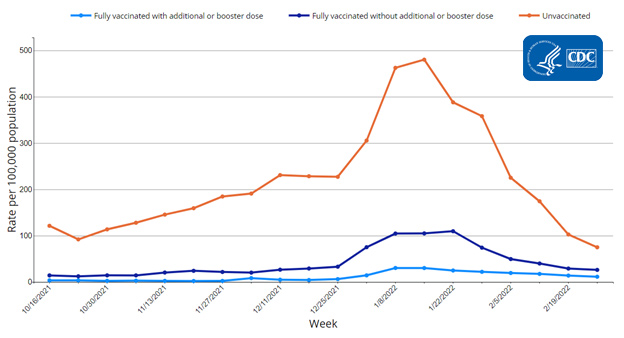
The Coronavirus Disease 2019 (COVID-19)-Associated Hospitalization Surveillance Network (COVID-NET) is an additional source for hospitalization data collected through a network of more than 250 acute-care hospitals in 14 states (representing ~10% of the U.S. population). Detailed data on patient demographics, including race/ethnicity, underlying medical conditions, medical interventions, and clinical outcomes, are collected with a standardized case reporting form.
Deaths
The current 7-day moving average of new deaths (627) has decreased 14.4% compared with the previous 7-day moving average (732). As of March 30, 2022, a total of 977,495 COVID-19 deaths have been reported in the United States.
977,495
Total Deaths Reported
977,495
Total Deaths Reported
627
Current 7-Day Average*
627
Current 7-Day Average*
732
Prior 7-Day Average
732
Prior 7-Day Average
-14.4%
Change in 7-Day Average Since Prior Week
-14.4%
Change in 7-Day Average Since Prior Week
*Historical deaths are excluded from the daily new deaths and 7-day average calculations until they are incorporated into the dataset by their applicable date. Of 20,744 historical deaths reported retroactively, none were reported in the current week; and none were reported in the prior week.
Daily Trends in Number of COVID-19 Deaths in the United States Reported to CDC

7-Day moving average
 More Death Data
More Death DataTesting
The percentage of COVID-19 NAATs (nucleic acid amplification tests)* that are positive (percent positivity) is increasing in comparison to the previous week. The 7-day average of percent positivity from NAATs is now 2.4%. The 7-day average number of tests reported for March 18-24, 2022, was 828,775, down 5.9% from 880,869 for the prior 7 days.
847,101,104
Total Tests Reported
847,101,104
Total Tests Reported
828,775
7-Day Average Tests Reported
828,775
7-Day Average Tests Reported
2.4%
7-Day Average % Positivity
2.4%
7-Day Average % Positivity
2.2%
Previous 7-Day Average % Positivity
2.2%
Previous 7-Day Average % Positivity
+0.23
Percentage point change in 7-Day Average % Positivity since Prior Week
+0.23
Percentage point change in 7-Day Average % Positivity since Prior Week
*Test for SARS-CoV-2, the virus that causes COVID-19


